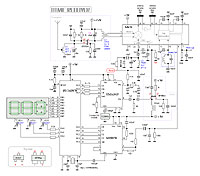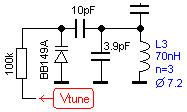

 DTMF Radio Receiver
DTMF Radio Receiver The complete background about this project can be found at my "Wife replace" project.
This part is a FM receiver based on a PLL synthesizer UMA1015.
The complete background about this project can be found at my "Wife replace" project.
This part is a FM receiver based on a PLL synthesizer UMA1015.  Preamplifier:
Preamplifier: In the SA615 you will find an oscillator at pin 3 and 4. This oscillator is connected internally
to mixer 1.
In the SA615 you will find an oscillator at pin 3 and 4. This oscillator is connected internally
to mixer 1. |
 |
| repeat_rec.zip | DTMF Radio Receiver program (the hex file is zipped!). |
| plls.zip | Basic function of PLL (the doc file is zipped!). |
 Final word
Final word